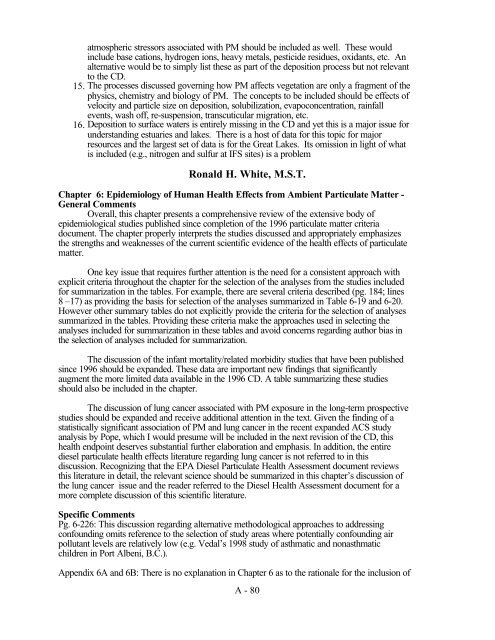Review of the Air Quality Criteria Document for Particulate Matter
Review of the Air Quality Criteria Document for Particulate Matter
Review of the Air Quality Criteria Document for Particulate Matter
- No tags were found...
You also want an ePaper? Increase the reach of your titles
YUMPU automatically turns print PDFs into web optimized ePapers that Google loves.
atmospheric stressors associated with PM should be included as well. These wouldinclude base cations, hydrogen ions, heavy metals, pesticide residues, oxidants, etc. Analternative would be to simply list <strong>the</strong>se as part <strong>of</strong> <strong>the</strong> deposition process but not relevantto <strong>the</strong> CD.15. The processes discussed governing how PM affects vegetation are only a fragment <strong>of</strong> <strong>the</strong>physics, chemistry and biology <strong>of</strong> PM. The concepts to be included should be effects <strong>of</strong>velocity and particle size on deposition, solubilization, evapoconcentration, rainfallevents, wash <strong>of</strong>f, re-suspension, transcuticular migration, etc.16. Deposition to surface waters is entirely missing in <strong>the</strong> CD and yet this is a major issue <strong>for</strong>understanding estuaries and lakes. There is a host <strong>of</strong> data <strong>for</strong> this topic <strong>for</strong> majorresources and <strong>the</strong> largest set <strong>of</strong> data is <strong>for</strong> <strong>the</strong> Great Lakes. Its omission in light <strong>of</strong> whatis included (e.g., nitrogen and sulfur at IFS sites) is a problemRonald H. White, M.S.T.Chapter 6: Epidemiology <strong>of</strong> Human Health Effects from Ambient <strong>Particulate</strong> <strong>Matter</strong> -General CommentsOverall, this chapter presents a comprehensive review <strong>of</strong> <strong>the</strong> extensive body <strong>of</strong>epidemiological studies published since completion <strong>of</strong> <strong>the</strong> 1996 particulate matter criteriadocument. The chapter properly interprets <strong>the</strong> studies discussed and appropriately emphasizes<strong>the</strong> strengths and weaknesses <strong>of</strong> <strong>the</strong> current scientific evidence <strong>of</strong> <strong>the</strong> health effects <strong>of</strong> particulatematter.One key issue that requires fur<strong>the</strong>r attention is <strong>the</strong> need <strong>for</strong> a consistent approach wi<strong>the</strong>xplicit criteria throughout <strong>the</strong> chapter <strong>for</strong> <strong>the</strong> selection <strong>of</strong> <strong>the</strong> analyses from <strong>the</strong> studies included<strong>for</strong> summarization in <strong>the</strong> tables. For example, <strong>the</strong>re are several criteria described (pg. 184; lines8 –17) as providing <strong>the</strong> basis <strong>for</strong> selection <strong>of</strong> <strong>the</strong> analyses summarized in Table 6-19 and 6-20.However o<strong>the</strong>r summary tables do not explicitly provide <strong>the</strong> criteria <strong>for</strong> <strong>the</strong> selection <strong>of</strong> analysessummarized in <strong>the</strong> tables. Providing <strong>the</strong>se criteria make <strong>the</strong> approaches used in selecting <strong>the</strong>analyses included <strong>for</strong> summarization in <strong>the</strong>se tables and avoid concerns regarding author bias in<strong>the</strong> selection <strong>of</strong> analyses included <strong>for</strong> summarization.The discussion <strong>of</strong> <strong>the</strong> infant mortality/related morbidity studies that have been publishedsince 1996 should be expanded. These data are important new findings that significantlyaugment <strong>the</strong> more limited data available in <strong>the</strong> 1996 CD. A table summarizing <strong>the</strong>se studiesshould also be included in <strong>the</strong> chapter.The discussion <strong>of</strong> lung cancer associated with PM exposure in <strong>the</strong> long-term prospectivestudies should be expanded and receive additional attention in <strong>the</strong> text. Given <strong>the</strong> finding <strong>of</strong> astatistically significant association <strong>of</strong> PM and lung cancer in <strong>the</strong> recent expanded ACS studyanalysis by Pope, which I would presume will be included in <strong>the</strong> next revision <strong>of</strong> <strong>the</strong> CD, thishealth endpoint deserves substantial fur<strong>the</strong>r elaboration and emphasis. In addition, <strong>the</strong> entirediesel particulate health effects literature regarding lung cancer is not referred to in thisdiscussion. Recognizing that <strong>the</strong> EPA Diesel <strong>Particulate</strong> Health Assessment document reviewsthis literature in detail, <strong>the</strong> relevant science should be summarized in this chapter’s discussion <strong>of</strong><strong>the</strong> lung cancer issue and <strong>the</strong> reader referred to <strong>the</strong> Diesel Health Assessment document <strong>for</strong> amore complete discussion <strong>of</strong> this scientific literature.Specific CommentsPg. 6-226: This discussion regarding alternative methodological approaches to addressingconfounding omits reference to <strong>the</strong> selection <strong>of</strong> study areas where potentially confounding airpollutant levels are relatively low (e.g. Vedal’s 1998 study <strong>of</strong> asthmatic and nonasthmaticchildren in Port Albeni, B.C.).Appendix 6A and 6B: There is no explanation in Chapter 6 as to <strong>the</strong> rationale <strong>for</strong> <strong>the</strong> inclusion <strong>of</strong>A - 80
















